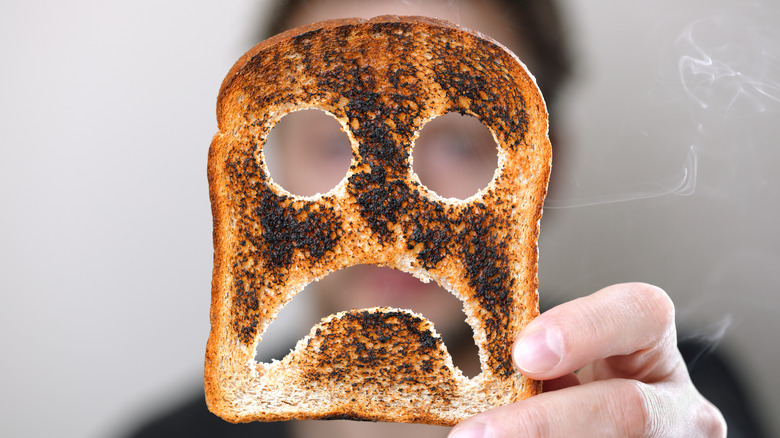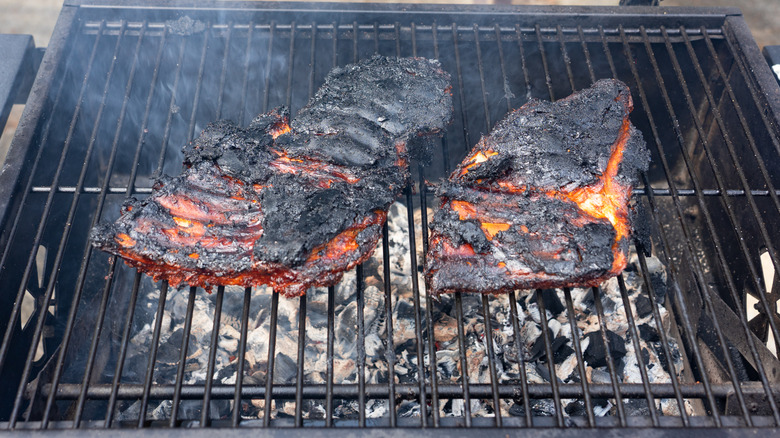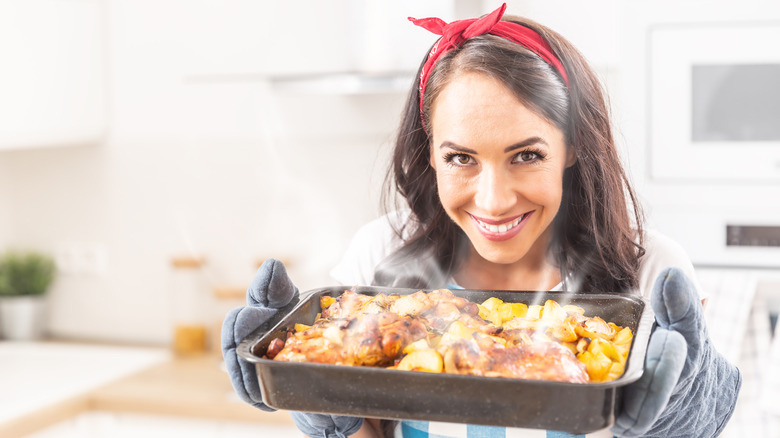Here's Why You Should Think Twice About Eating Burnt Food
Do you ever find yourself craving burnt food? Many people love the flavor of slightly burnt popcorn or burnt toast with butter. Nuoc mau, a nearly-burnt sugar sauce, is a staple of Vietnamese cuisine, says the Los Angeles Times. This bitter-sweet syrup gives meat, fish, rice, and other Vietnamese dishes a beautiful amber color.
The BBC reports that top restaurants from all around the world are featuring burnt foods on their menus — and customers seem to love it. A popular café in L.A., for example, offers burnt brioche bread with jam and cheese. The popular French crème brûlée is made with nearly-burnt caramelized sugar. If you go to Mexico, you'll find that many dishes are served with burnt tomato sauce.
All in all, burning food on purpose is actually a thing. Love it or hate it, this trend won't go away anytime soon. Unfortunately, the rumors are true: burnt food carries serious health risks and may cause problems down the road.
Is eating burnt food bad for you?
Rumors say that eating burnt food can cause cancer in the long run. The evidence is mixed, though. Cooking bread, potatoes, and other starchy foods for long periods leads to the formation of acrylamide, a potential human carcinogen. Overcooked meat and fish are less likely to contain this toxin, says the FDA. However, meat may have high levels of polycyclic aromatic hydrocarbons (PAHs) and heterocyclic amines (HCAs), according to the Dana-Farber Cancer Institute.
These compounds have been linked to cancer, "but studies suggest that these 'likely' carcinogens are actually unlikely to cause the most common types of cancer," per the Dana-Farber Cancer Institute. Acrylamide, for example, may increase the risk of kidney, ovarian, and endometrial cancers. The problem is that most studies were small or inconsistent, making it hard to draw a conclusion, notes the University of Cambridge.
Scientists say that exposure to high levels of acrylamide can cause cancer, but most foods only contain small doses of this toxin. The same goes for HCAs and PAHs, reports the Dana-Farber Cancer Institute. Both compounds have the potential to cause cancer, but there's not enough evidence to confirm these risks.
How to cook food with low acrylamide levels
An occasional slice of burnt toast with avocado or butter is unlikely to cause any harm. Just make sure you don't make a habit out of eating burnt food daily or every other day. The FDA recommends cooking starchy foods until they achieve a golden yellow color to keep their acrylamide levels low.
If you love potatoes, enjoy them roasted instead of frying them. Better yet, boil or microwave them with the skin on to prevent acrylamide formation. Another option is to cut them into slices and then soak them in water for 15 minutes or longer before frying or roasting them. This trick can reduce their acrylamide content, says the FDA. As far as bread goes, it's best to toast it to a light brown color.
When it comes to HCAs and PAHs, the Dana-Farber Cancer Institute advises against cooking meat products over an open flame. Scrape off the charred portions of meat and fish before serving. The experts at Dana-Farber Cancer Institute also suggest microwaving meat prior to grilling, frying, or roasting it. This will reduce the cooking time, resulting in lower HCA levels.


